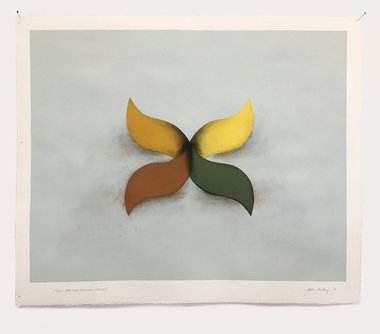John Hurrell – 20 October, 2024
These are very different from the images in Bailey's Scott Lawrie presentation of last year, where flickering flat coloured circles were clinging to positive and negative Y-shaped structures. Bailey's fifteen more recent drawings—made with acrylic, charcoal and pastel—have a freer spatial feel that is now more immersive (a deeper space) and far less beholden to the picture-plane. Indeed, the floating banner forms are highly ambiguous.
John Bailey is usually remembered for his Bochner / LeWitt inspired (site-specific and mathematical) works of the late seventies, though his red Equinox works four years later (diagrams of moving sunlight) are very different.
This current show of drawings is not preoccupied with systems or architectural structure, but features an interest in the emotional properties of colour and elegant design, showcasing twisting banner forms with pointed tips that hover in space. They are not frontal or in sideways profile but at a three-quarter angle, to catch the modelling effects of raking illumination on inner and outer curved surfaces.
These 3D buckled banner forms, of wobbly thin curved rectangles, can also be seen when compressed as double-tipped tear drops, as globes simultaneously pulled in opposite directions.
They are very different from the images in Bailey’s Scott Lawrie presentation of last year, where flickering flat coloured circles were clinging to positive and negative Y-shaped structures. Bailey’s fifteen recent drawings—made with acrylic, charcoal and pastel—have a freer spatial feel that is now more immersive (a deeper space) and far less beholden to the picture-plane. Indeed, the floating banner forms are highly ambiguous. They could be thin unfurled strips in suspension—but animated—or else from some angles, say, fat chubby slugs.
This is because at each end one corner is transmuted into a curve-turning the other corner into an acute-angled point. Bailey is thus exploiting the nuances of a multi-interpretable shape that comes from turning or revolving bands that are foreshortened, and perception that’s dependent on oblique viewer angles.
Surprisingly this motif-based show has a restrained Surrealist undercurrent that is not immediately obvious because it is so carefully designed, with affinities to earlier artists like John Lethbridge of the late eighties. Two of the titles reference de Chirico and de Lautréamont specifically, and one other playfully depicts female body parts that indirectly hint at Surrealism and masturbation. Very few have a dreamlike otherworldly sensibility, as most exploit a formal elegance with the forms quivering in mid-air, like frolicking butterflies or spinning children’s windmills.
In contrast, a couple of other works feature vertical configurations that are knotted or threaded together in structure. They seem to depict a freestanding sculpture made of compressed coloured fabric, that has links with drooping leaves and withered petals. They are unusual in that they are anchored, linear, taut and rhythmic. A sort of pulsing streaming fountain stretched between bottom and upper paper edges. The more you examine them, the more intriguing they become.
Bailey’s nifty manner of manipulating the perception of shape that is initially simple when flattened out, but more complex when buckled, results in an intriguing playfulness via the turning permutations, that forces the perceiving viewer to analyse possible spatial options. And maybe delight even in the ‘wrong’ ones because they are so surprising—as part of a subconscious thought-system of value, that sooner or later can beneficially be raised to the surface.
John Hurrell








 Two Rooms presents a program of residencies and projects
Two Rooms presents a program of residencies and projects Advertising in this column
Advertising in this column



This Discussion has 0 comments.
Comment
Participate
Register to Participate.
Sign in
Sign in to an existing account.